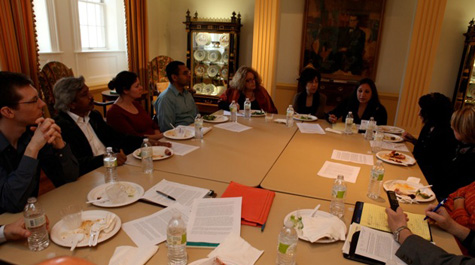W&M nears partnership with Indian universities
“You have to have global and multi-cultural competencies for our students,” Ochoa said, “and that is best achieved if you have a diverse multi-national student body. It’s important.”
Ochoa said that although the percentage of international students in the United States has dropped from just under 25 percent in 2000 to 18 percent in 2008, that percentage is still the highest globally.
“The rest of the world is realizing, just like the United States, that higher education is becoming a key component for global success in the 21st century,” Ochoa said.
Ochoa’s visit was tied to the College’s participation in the United States-India partnership, funded by the U.S. Department of Education for the Improvement of Post-Secondary Education.
Last spring, William & Mary was one of 10 colleges and universities chosen for a new pilot program on educational partnerships between the United States and India. In fall 2010, Ochoa was part of a delegation that included William & Mary Vice-Provost for Academic Affairs Kate Slevin and other college representatives from across the country that traveled to India for meetings with representatives from the U.S. Department of State, the U.S. Department of Education, the Indian Ministry of Education, and the Fulbright Commission.
In addition, the College’s delegation met independently with the leaders of three institutions chosen by William & Mary faculty: The National Law School of India at India University, St. Xavier’s College in Mumbai, and St. Stephen’s College in New Delhi, India’s oldest college.
“The question was what were the right universities, the right places to go,” said Professor of Economics Arnab Basu, a member of the W&M delegation. “We wanted institutions that were similar to William & Mary in terms of prestige, the quality of education they offer, and other logistics such as being located in main cities.
“St. Stephen’s is very much like us, a beautiful campus, full of history. The National Law School in Bangalore is one of the best in South Asia, a top-notch law school set up by the government of India many years ago. We looked at that as a unique opportunity . . . India has an amazing amount of social issues, very complex, that fly in the face of what we believe should be happening in the modern day in an emerging democracy. It is a great place for students interested in human rights and interdisciplinary issues, not just law students.”
In addition to Ochoa’s appearance, the first tangible results of W&M’s interest in a partnership with India have just been completed: one-credit, two-week courses taught at the College by visiting professors S. Japhet of The National Law School of India University and Karen Gabriel of St. Stephen’s.
Gabriel lectured on “Gender, Sexuality and Nation in Contemporary Mainstream Bombay Cinema.” Japhet, who also directs the Centre for the Study of Social Exclusion and Inclusive Policy at The National Law School, taught “Law, Equality and Social Exclusion in Contemporary India.” Ochoa met with students from both of those classes.
“It exceeded our expectations,” Slevin said. “It was our first attempt to formally engage in any sort of partnership with Indian universities through this initiative. We were unsure how it would work out. But both professors were very engaged while here with students and faculty in multiple disciplines and schools. Not surprisingly, they were very impressed with the quality of our students, and they really enjoyed their contact with our professors.
“Lots of potential research areas emerged between the Indian faculty members and our faculty, and those will develop as time goes on.”
Slevin said that the College wants the partnerships to be “organic,” meaning the programs emerge from interaction with students and, especially, faculty.
“Our faculty’s involvement and support is absolutely crucial to this being a success,” Slevin said.
A luncheon involving the visiting professors and a dozen of their W&M counterparts from a broad spectrum of disciplines resulted in a free flow of ideas.
Among them:
• William & Mary students engaged in both short-term and long-term exchanges with St. Stephen’s and The National Law School. The short-term program might feature a three-week, faculty-led, 10-15 student winter program at both Indian institutions, supplemented by participation in a community-service program. The trip would be preceded at home by independent study during the fall semester. Language courses would be made available at both institutions.
In the long term, both one-semester and one-year programs would be implemented.
• Student exchanges from St. Stephen’s to W&M. Because of the rigid structure of the Indian higher-education system, St. Stephen’s students would almost certainly have to participate in summer classes here and at the College’s Washington, D.C. location. Following graduation, St. Stephen’s students could be offered the opportunity to complete a one-semester exchange here.
“We can project to these colleges that we’re not just confined to Williamsburg,” Basu said. “We have a national, a global reach.”
• Faculty exchanges between St. Stephen’s and the National Law School and W&M. The two-week courses inaugurated by S. Japhet and Karen Gabriel would continue every spring and fall.
• A faculty exchange of W&M professors to St. Stephen’s or The National Law School would take place in the winter. Slevin indicated that W&M students could begin traveling to India for study as soon as January, 2012. W&M faculty traveling to India is a bit more problematic because of funding.
“We’re in the process of trying to organize funds,” Slevin said. “We know that the Obama – Singh Funds are supposedly coming up in the next several months, and those very likely help us stabilize these initiatives. The development of faculty exchanges seems likely, and a natural part of this partnership.”















